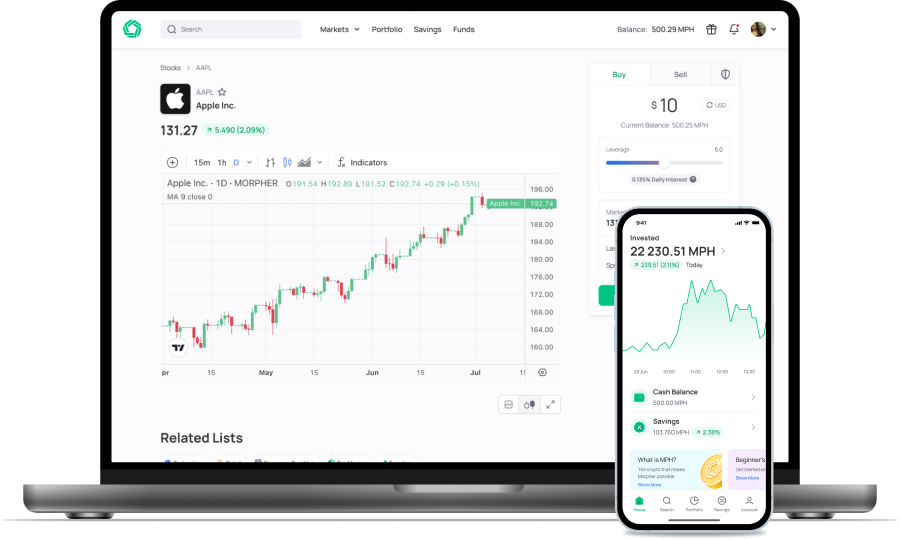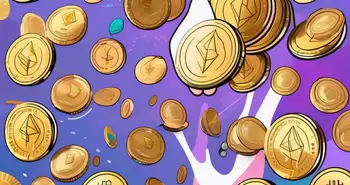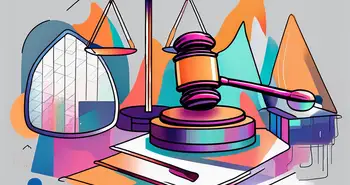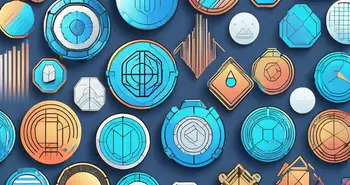NFTs Explained for Dummies

Once dismissed as mere little JPEGs, NFTs (Non-Fungible Tokens) have evolved into a versatile technology with countless applications. If you've found yourself scratching your head, feeling like a dummy in this new space, do not worry, we are here to help! The truth is NFTs have expanded so rapidly that it's become nearly impossible to keep up with their ever-growing possibilities. In this article, we aim to provide a beginner-friendly overview, from understanding what NFTs are to exploring their wide-ranging applications and even the different ways how to get started with them. So, let's embark on a journey to demystify NFTs and unravel the world of unique digital ownership. And if you ever feel overwhelmed, take solace in the words of Fred Ehrsam:
“NFTs are a way to own a unique digital item. Today it's mostly digital visual art, but they can—and will—apply to anything digital: music, writing, video game items, and more. NFTs have authenticity because creators sign them digitally, similarly to how an artist would sign a physical painting.”
What are NFTs
NFTs, or non-fungible tokens, represent unique assets that stand apart from identical ones. Imagine fungible tokens as everyday currency or widely recognized cryptocurrencies, interchangeable and indistinguishable. However, non-fungible items, like a famous artwork or your cherished pet, possess individuality that cannot be replicated or replaced.
Bringing this concept to the digital world was once a challenge. Digital assets, comprised of simple 0s and 1s, could be effortlessly copied. Yet, with the advent of blockchain technology, the game has changed. The blockchain acts as a permanent global ledger, underpinning cryptocurrencies like Bitcoin and Ethereum, offering a secure and verifiable record for all.
Initially designed for financial transactions, the blockchain expanded its horizons. It became a trusted platform for irrevocable proof in various domains. By digitally signing a blockchain transaction with their private keys, individuals can certify the authenticity of an original NFT, forever linking it to its creator. Amid countless replicas, only the original NFT, adorned with the creator's digital signature, retains its title, embodying the essence of its artistic origin.
To summarize and clarify it again, NFTs are not only digital art. Non-Fungible Tokens are digital property; they allow for a way to verify ownership, originality, and authenticity in the digital realm. To make this concept even more clear, we will show what NFTs are composed of from a technical perspective and also show different use cases of how they can be used.
Key Components of NFTs
Key components of NFTs include the token ID, metadata, media, owner, creator, and minter. These components work together to establish uniqueness, ownership, and authenticity of digital assets. In general, NFTs operate on the Ethereum blockchain and are created through smart contracts based on the ERC-721 standard.
To better understand how NFTs work, let's consider an example involving “Doodles.” Imagine a smart contract that allows the minting of unique digital doodles as NFTs. The smart contract includes a “mint” function that verifies if there are remaining slots for minting doodles.

If there are available slots, the function creates a new NFT representing a distinct doodle and transfers it to the wallet address of the user who invoked the function. Each doodle has a specific token ID, metadata that contains additional information about the artwork, and the associated media, which could be an image or animation.
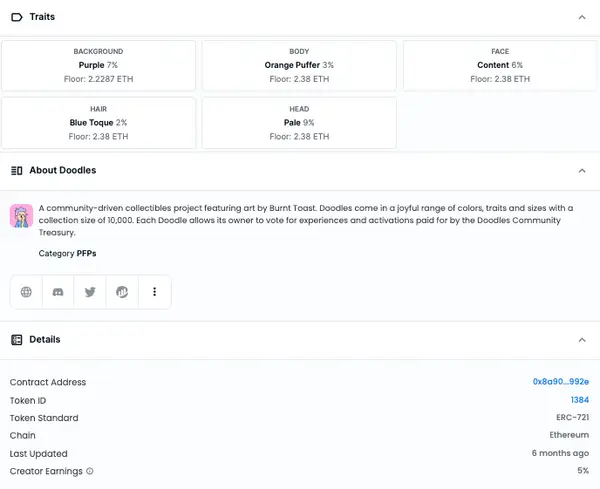
The Ethereum blockchain acts as a global decentralized computer, recording all the transactions and changes in state. For instance, if Alice mints a Doodle NFT by paying a certain amount of ETH, the blockchain updates the state to reflect Alice's reduced ETH balance and her ownership of the NFT, representing the unique doodle.
Later, if Alice decides to sell the doodle to Bob, the blockchain again updates the state to reflect the ownership transfer. Bob now holds the NFT, and the Ethereum blockchain records this change accordingly.

The shared state provided by the Ethereum blockchain allows for easy verification of NFT ownership and the history of transactions. By referring to the original smart contract and its associated metadata, anyone can verify the authenticity and ownership of a particular doodle NFT.
The adoption of the ERC-721 standard for NFTs ensures interoperability and simplifies the development of platforms and marketplaces. Developers can build applications that interact with users' Ethereum wallets, enabling the display, sale, or transfer of Doodle NFTs without the need for custom implementations for each individual artwork.
In summary, NFTs leverage the power of blockchain technology to establish digital scarcity, enable ownership verification, and provide a platform for the creation, buying, and selling of unique digital assets like Doodles.
Benefits and Use Cases of NFTs
Equitable Access: NFTs enable artists from anywhere in the world to have a fair shot at reaching a global audience and gaining recognition. Traditional art markets are often limited to a select group of artists and collectors, whereas NFT platforms provide accessible opportunities for artists to showcase their work and connect with a wider audience. Anyone can now just create artwork and publish it alongside famous artists.

Direct Artist Compensation: In traditional art markets, artists may receive little compensation for their work while intermediaries profit from sales. Moreover, current digital platforms take a big share of the revenue of creators, while the artists themselves only get a small percentage. We all know how musicians always complain about record labels taking such a big chunk of their work or Apple taking 30% straight up from every in-app purchase. With new platforms like Opensea, however, creators get almost all of the revenue, while Opensea simply takes a 2.5% transaction fee.

Perpetual Royalties: NFTs enable artists to receive perpetual royalties, even after their initial sale. Smart contracts can be programmed to automatically distribute royalties to artists or their estates every time the NFT is resold, providing long-term financial benefits to creators.
Elimination of Middlemen: NFTs cut out the need for intermediaries like galleries, dealers, and auction houses, reducing transaction costs and increasing liquidity. Artists can directly sell their work to collectors on digital platforms, empowering them with greater control over pricing and distribution. Here you can see how the artist “Tom Fry” is actually earning 10% (Creator earnings) from every resale, while he has sold a total volume of 185 ETH of artworks.

Increased Transparency: NFTs leverage blockchain technology, which provides a transparent and immutable record of ownership and transaction history. This transparency helps establish authenticity, provenance, and ownership rights, addressing concerns related to counterfeiting and fraud in the art market. In the picture below, you can see a visual representation of all the NFTs that famous artist Beeple has created. Moreover, you could also go to the blockexplorer Etherscan and actually see his newest transactions and NFT transfers that he is taking part in to literally see which projects the big artists are paying attention to.


Collectibles and Memorabilia: NFTs have extended beyond art and are being used to create and trade digital collectibles and memorabilia. These can include limited-edition trading cards, virtual items in video games, virtual real estate, and other unique digital assets. NFTs provide verifiable ownership and scarcity, enhancing the value of these collectibles.
“It was sort of a part of my identity. It was a mask. What are masks? They’re objects that you can project identity onto. And for 7804, the wise alien, I felt a bit different wearing it. And as soon as I sold it, it didn’t feel right to wear it anymore. And so I had to take it off. And now the person that’s wearing it, I’m like, “Wow, you are totally the wise alien, this is perfect.” But I definitely did feel very emotional about it. I felt extremely attached to it. It felt like a breakup to have sold it. I literally had dreams about it.”
Peruggia
This paradox of ownership is the ultimate challenge for any collector. We often hear, “Why are Cryptopunks so expensive?”. Here is the answer. As more people become invested in their tribe’s success, the PFP becomes a symbol of one’s identity and, therefore, less likely to be sold. And with high-profile names like Jay-Z, Snoop Dogg, Serena Williams, and Odell Beckham Jr. among the owners of CryptoPunks, it’s easy to see why many want to be part of one of the first NFT art projects.
Tokenization of Real-World Assets: NFTs can represent ownership rights to physical assets, such as real estate, luxury goods, or even fractional ownership in tangible items. By tokenizing these assets, NFTs enable fractional ownership, increased liquidity, and ease of transfer. For example, this would even enable us to trade real-world objects like stocks, but more to that later.

Real-World Applications of NFTs
NFTs, or non-fungible tokens, have opened up a world of possibilities across various domains. One fascinating use case is in the realm of music, as exemplified by an on-chain song NFT created using Arpeggi's composing tool. This NFT represents a fully digital collectible and also grants access to a small audience of super fans, as seen on Sound.xyz. Another application is in the realm of tickets, where NFTs enable low-friction, widely interoperable access. They can replace traditional tickets and facilitate digital access to exclusive experiences like private Discord servers or video lessons. As an example, the Bored Ape Yacht Club only allows people to join their community if they own a Bored Ape NFT:
“A limited NFT collection where the token itself doubles as your membership to a swamp club for apes. The club is open! Ape in with us.” – Bored Ape NFT
NFTs have also revolutionized the gaming industry, offering users true ownership of in-game objects. Unlike traditional virtual goods, which are owned by game companies, NFTs allow users to truly possess and trade these objects. This newfound ownership unlocks the potential for interoperability and composability across games, propelling innovation in the gaming ecosystem. Games like Axie Infinity and Top Shot have spearheaded this movement and have paved the way for upcoming web3 game development projects.
Furthermore, NFTs have introduced the concept of redeemables, where a token can be exchanged for physical goods. Unisocks pioneered this model, inspiring the application of redeemable NFTs to various offline goods, with many institutions following their path.

For instance, high-end collectors can now digitize their collections by creating tokens that represent their physical items, enabling them to be showcased and traded digitally. This approach reduces friction and intermediaries while expanding the possibilities for user experience. Also, Beeple is following this approach and is creating a hybrid of digital and physical NFTs.

In addition to these tangible applications, NFTs also offer solutions for identity management in the web3 era. Blockchains like Bitcoin and Ethereum, which underpin NFTs, provide a secure and decentralized alternative to the compromised web2 handling of personal information. With systems like ENS and login.xyz, users can securely log in and identify themselves across platforms. In the future, NFTs could even serve as repositories for records, credentials, and reputation, empowering individuals to control and selectively reveal aspects of their identity. Another application of that would be to have on-chain resumes or so-called crypto credentials that would instantly qualify you for a global job market and with which you can log into any site. Listen to Balaji Srinivasan explaining the concept of NFTs of Cryptocredentials even closer.
Furthermore, NFTs have the potential to disrupt centralized web2 databases by leveraging cryptographic methods and decentralized data stores. This technology can extend NFTs to encompass any information currently stored in centralized databases, from viewing preferences to comprehensive social graphs. This seamless data portability allows users to switch between services effortlessly while retaining full control of their own data, aligning with the vision of the web3 ecosystem.
There are also many random applications that people build like opening a car with your own car NFT or tokenizing yourself in an NFT so investors can vote on your life choices.
How to Get Started with NFTs
If you're interested in getting started with NFTs, there are several ways to dive into this exciting world. Let's explore the different methods, starting from the easiest and gradually progressing to more involved options:
Buying NFTs on an NFT platform
- Create an account on a platform like OpenSea, a popular NFT marketplace.
- Set up a crypto wallet (such as MetaMask) to store your digital assets.
- Connect your wallet to OpenSea and fund it with cryptocurrency.
- Browse through the vast collection of NFTs available and purchase the ones that catch your eye.
Participating in Minting NFTs
When participating in a mint of a project, the artwork is typically created by the project or the artist associated with the project. As a participant, you are acquiring the NFTs that are being minted by the project. The project or artist sets the parameters and designs the artwork or digital content that will be turned into NFTs. Your role is to be part of the minting process by acquiring those NFTs directly from the project or artist.
- Research artists or projects that offer opportunities to mint NFTs.
- Minting refers to the process of creating and tokenizing digital assets as NFTs.
- Keep an eye on announcements and social media platforms to stay informed about new drops.
- Prepare your wallet with the required cryptocurrency and be ready to mint the NFTs as soon as they become available.
Trading and Investing in NFTs
Trading NFTs is a popular way to participate in the NFT hype. However, it can be expensive and require a substantial amount of capital, especially if you want to trade popular collections like Azuki NFTs or Doodles. To start trading on a small scale, you would need at least $50,000. Additionally, highly sought-after collections like Cryptopunks or Bored Ape Yacht Club are not easily tradable as owners are reluctant to sell them. For these collections, you would need a minimum investment of $300,000 just to trade two or three NFTs.
Fortunately, there's a simpler and better solution for NFT trading available on Morpher. On Morpher, you can trade the esteemed collections mentioned earlier for as little as $1. Moreover, you have the option to trade a whole index, which allows you to profit from major sales rather than relying solely on less sought-after NFTs. Additionally, you can trade NFTs in a manner similar to stocks or currencies, using your favorite technical indicators or candlestick patterns. This creates a never-before-seen tradable market.
You might find it hard to believe, but let us show you the trading charts for NFTs on Morpher.
- Register on Morpher and verify your account
- Choose the Unique Markets and select NFTs
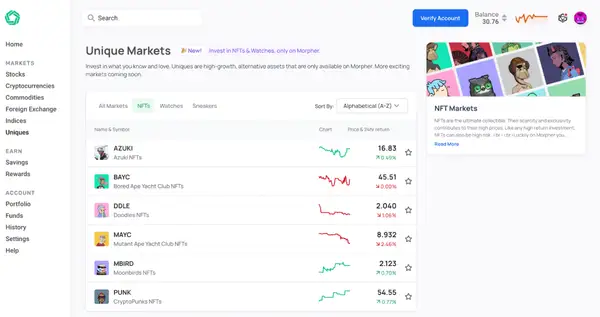
- Choose a collection and start trading
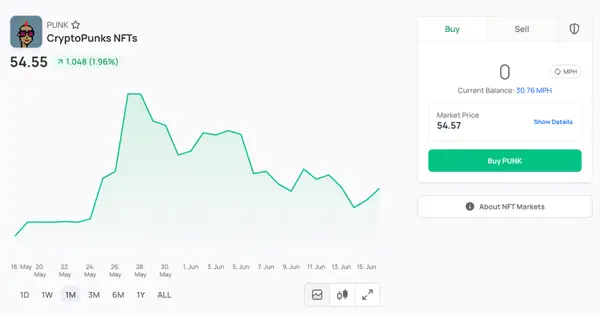
- Enjoy the convenience of trading with various indicators and tracking price movements of major collections like Cryptopunks, Zombie Bored Ape Club, Azukis, Doodles, and many more.

Criticisms and Controversies Surrounding NFTs
One common criticism of NFTs is that they are perceived as worthless because anyone can right-click and save them. The argument is that if something can be easily replicated at no cost, it loses its value. This viewpoint questions the monetary worth of digital art, disregarding the effort, creativity, and technical complexity put into the artwork. Since digital art can be infinitely replicated, some argue that it lacks the scarcity that gives physical art value.
However, it is important to recognize that digital art holds its own artistic merit. Digital artists can possess the same level of skill, if not more, than physical artists. Additionally, digital art offers new possibilities and art forms that go beyond what can be achieved in the physical world. Generative art, created using computer algorithms and AI, is an example of such innovation.
Critics often dismiss NFTs as scams, claiming they are merely stealing money from those caught up in the hype. However, it is essential to consider the transformative potential of NFTs as a technological innovation. Similar skepticism was encountered in the early days of the internet, where many doubted its long-term impact. Today, the internet is an integral part of our lives.
It is natural for new technologies to face skepticism initially. Throughout history, inventions like airplanes, cars, computers, and calculators have been met with doubt and criticism. Yet, they have revolutionized various aspects of our society. NFTs and cryptocurrencies are no exception. They are rooted in significant technical breakthroughs, such as blockchain technology, which took years of research and development. It is crucial to approach skepticism with an open mind, considering the historical patterns of skepticism towards innovative technologies. NFTs and cryptocurrencies may be abstract and less tangible than previous inventions, but they have the potential to reshape our economic and societal landscapes.
Criticism surrounding NFTs is not uncommon, with arguments focusing on their replicability and perceived lack of value. However, it is important to recognize the artistic merit of digital art, the potential for new art forms, and the transformative nature of NFTs as a technological innovation. While skepticism exists, history has shown that initial doubts are not always an accurate reflection of the long-term impact of groundbreaking technologies.
The Future of NFTs
What began as digital tokens representing little more than JPEGs and art pieces has now expanded to encompass numerous areas of innovation. As you can see, NFTs have found their applications in diverse sectors, ranging from gaming and music to identity management and cultural preservation. They have revolutionized the concept of a fairer creator economy, providing artists and creators with new avenues for monetization and ownership of their work. Moreover, NFTs have paved the way for crypto credentials and pass into exclusive communities, creating a seamless bridge between the digital and physical realms. As we witness the continuous development and advancement of these technologies, we find ourselves at the forefront of a journey where the possibilities are vast and largely unknown. It is still early in the evolution of NFTs, and we can only imagine where this transformative force will lead us.
“It’s worth acknowledging how early NFTs are as a new form factor. Just like it took lots of people trying to make different kinds of websites in the early internet, it will take a lot of experimentation with NFTs.”
Fred Ehrsam
Conclusion
In conclusion, we have covered a wide range of topics in our exploration of NFTs, providing a comprehensive understanding for you as a reader. We started with the basics, explaining what NFTs are and delving into the key components that make them unique. We then discussed the benefits and use cases of NFTs, exploring their real-world applications across various industries. Additionally, we offered guidance on how to get started with NFTs, equipping you with the necessary knowledge to dive into this exciting new technology. However, NFTs are such a vast and dynamic topic that entire NFT podcasts are solely about this space. Also, for those seeking a deeper understanding, I recommend checking out Ben Yu's 115-minute-long holy grail piece on NFTs 101, which provides a comprehensive review of the industry's history. After reading this article, it should be evident just how important NFTs have become in today's digital landscape. For those looking to start with minimal financial investment, trading NFTs on platforms like Morpher can be an excellent entry point.
“NFTs are the ultimate collectible. Their scarcity and exclusivity contributes to their high prices. Like any high-return investment, NFTs can also be high risk.
Fortunately, on Morpher, you invest in the price movement of an entire collection rather than just one artwork. Each NFT market represents a complete collection, typically consisting of over 10,000 individual artworks. For instance, when more Bored Apes are sold at higher prices, the Bored Ape Yacht Club (BAYC) market price increases.
The most valuable digital artworks, the NFTs with the highest prices, are usually too expensive to purchase outright. Morpher allows you to invest in the best regardless of your bank account size.”
Morpher

So, go forth and explore the fascinating world of NFTs, where digital ownership and creativity intertwine in unprecedented ways.

Disclaimer: All investments involve risk, and the past performance of a security, industry, sector, market, financial product, trading strategy, or individual’s trading does not guarantee future results or returns. Investors are fully responsible for any investment decisions they make. Such decisions should be based solely on an evaluation of their financial circumstances, investment objectives, risk tolerance, and liquidity needs. This post does not constitute investment advice.

Painless trading for everyone
Hundreds of markets all in one place - Apple, Bitcoin, Gold, Watches, NFTs, Sneakers and so much more.

Painless trading for everyone
Hundreds of markets all in one place - Apple, Bitcoin, Gold, Watches, NFTs, Sneakers and so much more.
